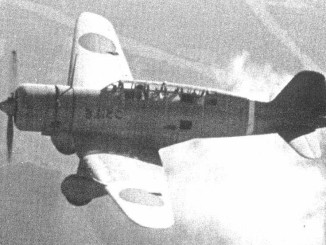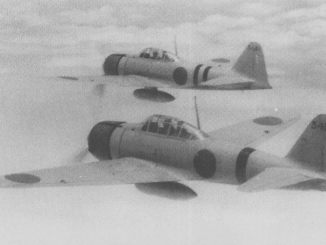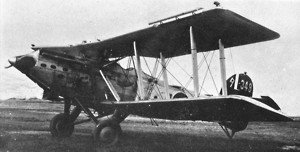
The 9-Shi specification for an advanced carrier fighter was issued by the Japanese Navy in 1934, calling for an aircraft with a top speed of 350km/h (high for the time) and an ability to climb to 5,000m in 6.5 minutes or less. The new aircraft was to be designed to replace the A2N and A4N biplanes then in service aboard Japanese aircraft carriers. Mitsubishi responded with what what later be known as the A5M Claude.
Mitsubishi assigned Jiro Horikoshi as the lead designer for their entry, who initially produced a design with an inverted gull wing (similar to the much later Vought F4U). The fighter was a monoplane with fixed, spatted landing gear as retractable gear was thought to be too costly in terms of added weight. The Ka-14, as the designed was known internally at Mitsubishi, was powered by a 600hp Nakajima Kotobuki 5 engine, and attained a maximum speed of 450km/h – far in excess of the design requirement. Although production A5M models dispensed with the gull wing in favour of a more conventional straight wing, the type retained the high speed.
A5Ms assigned to Kaga were the first to see action during the Battle of Shanghai, and later were assigned to land bases around the city. The type was regularly seen carrying an external drop tank, becoming one of the first aircraft to make use of these to extend range. A5Ms fought with American designed Boeing 281 (P-26Cs) in what were the first ever air combats between opposing metal-construction monoplanes. They were also used to escort G3M bombers which had suffered heavily when carrying out unescorted raids on Chinese airfields, a precursor of the G4M/A6M team which would devastate Allied bases during the Pacific War.
The A5M was the primary IJN fighter throughout the Sino-Japanese War, until the A6M Zero started to appear in small numbers 1940. Even so the A5M continued in service through the first year of the wider Pacific War, fighting at the Battle of Coral Sea flying from the light carrier Shoho. Later, remaining A5Ms were pressed into service with the kamikaze units, attacking American ships off Okinawa and the Home Islands.
In 1942, the A5M was assigned the Allied reporting name “Claude”.
Mitsubishi A5M Type 96 Specifications
| Mitsubishi A5M1 | |
| Role | |
| Crew | |
| Powerplant | 1x Nakajima Kotobuki 2-kai-1 (585hp) |
| Speed | |
| Ceiling | 0ft |
| Range | |
| Armament | |
| Ordnance | |
| Dimensions | 0ft 0in (length) 0ft 0in (wingspan) 0ft 0in (height) |
| Weight | |
| Mitsubishi A5M4 | |
| Role | Carrier Fighter |
| Crew | 1 |
| Powerplant | 1x Nakajima Kotobuki 41 (785hp) |
| Speed | 273mph (max) |
| Ceiling | 32,150ft |
| Range | 746 miles (internal) |
| Armament | 2x Type 92 7.7mm Machine Gun |
| Ordnance | |
| Dimensions | 24ft 9in (length) 36ft 1in (wingspan) 10ft 6in (height) |
| Wing Area | 191 sq.ft. |
| Weight | 2,681lb (empty) 3,759lb (gross) 4,017lb (max) |
| Number produced | 980 |




Leave a Reply